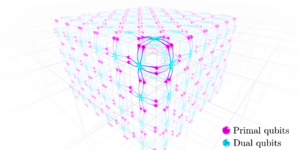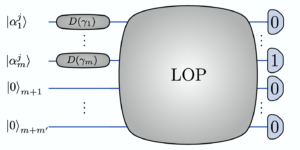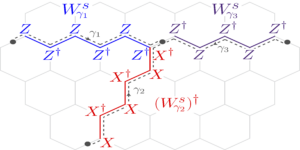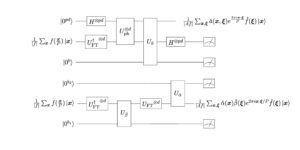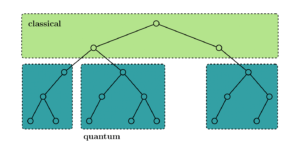1Institute of Physics, Yerevan State University, 0025 Yerevan, ArmeniaAlikhanian National Laboratory, 0036 Yerevan, Armenia
2Energy densities in quantum mechanics
Find this paper interesting or want to discuss? Scite or leave a comment on SciRate.
Abstract
Quantum mechanics does not provide any ready recipe for defining energy density in space, since the energy and coordinate do not commute. To find a well-motivated energy density, we start from a possibly fundamental, relativistic description for a spin-$frac{1}{2}$ particle: Dirac’s equation. Employing its energy-momentum tensor and going to the non-relativistic limit we find a locally conserved non-relativistic energy density that is defined via the Terletsky-Margenau-Hill quasiprobability (which is hence selected among other options). It coincides with the weak value of energy, and also with the hydrodynamic energy in the Madelung representation of quantum dynamics, which includes the quantum potential. Moreover, we find a new form of spin-related energy that is finite in the non-relativistic limit, emerges from the rest energy, and is (separately) locally conserved, though it does not contribute to the global energy budget. This form of energy has a holographic character, i.e., its value for a given volume is expressed via the surface of this volume. Our results apply to situations where local energy representation is essential; e.g. we show that the energy transfer velocity for a large class of free wave-packets (including Gaussian and Airy wave-packets) is larger than its group (i.e. coordinate-transfer) velocity.
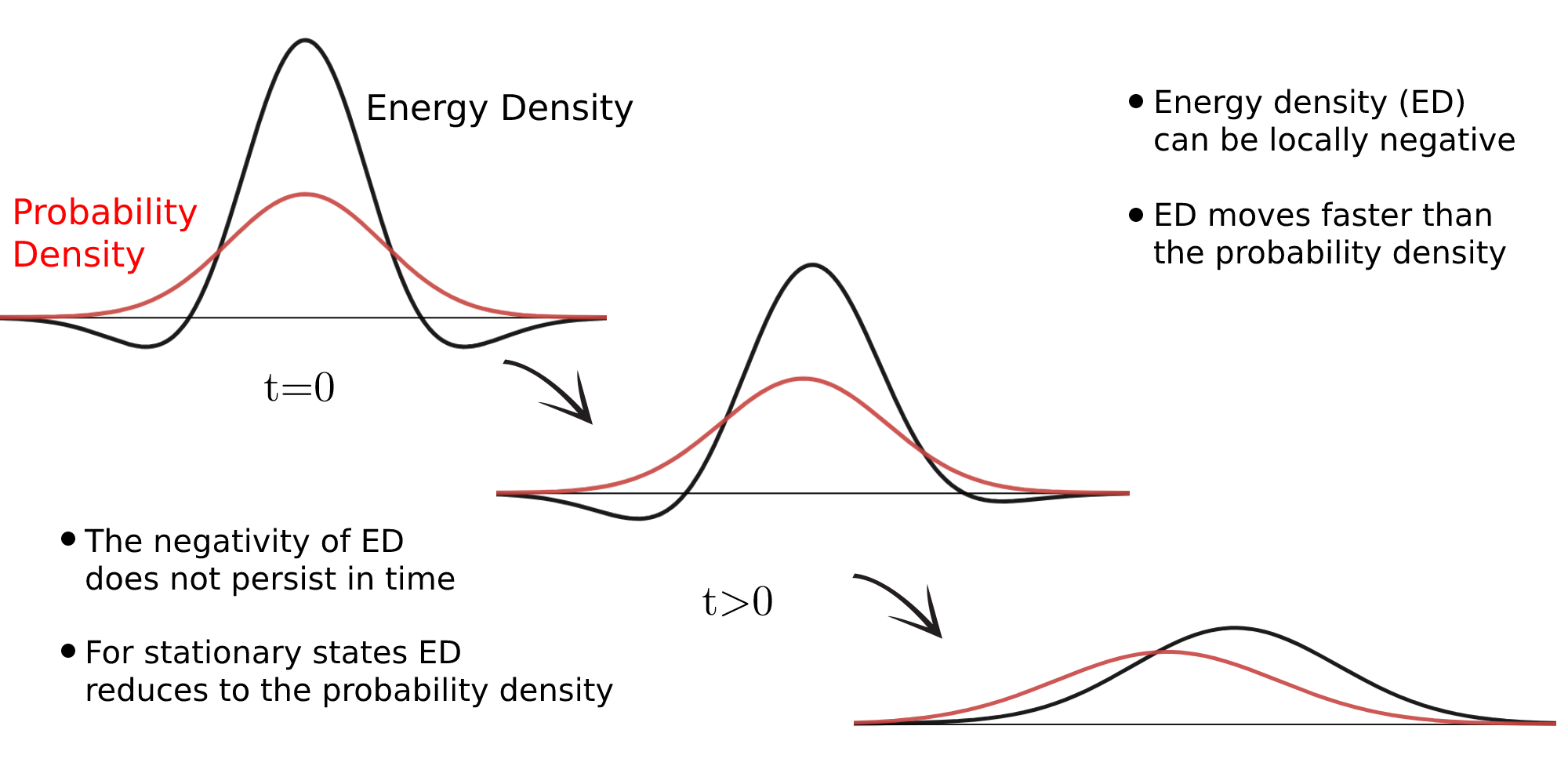
Featured image: Energy density (black) and probability density (red) of a Gaussian wave packet. Energy density can be locally negative. Energy transfer velocity is larger than group velocity.
Popular summary
When deriving this energy density from Dirac’s equation, we identify a new form of spin-related energy density, which is finite in the non-relativistic limit and emerges from the rest energy. This energy is locally conserved but it nullifies for most simple quantum mechanical states. Moreover, its total value is always zero so it has no contribution to the global energy of the particle. It is a holographic property, meaning that its volumetric value depends on its surface. This new energy density is thus worth studying and identifying in experiments.
► BibTeX data
► References
[1] L. D. Landau and E. M. Lifshitz. “Quantum mechanics”. Volume 94. Pergamon Press, Oxford. (1958).
[2] Michael V Berry and Nandor L Balazs. “Nonspreading wave packets”. American Journal of Physics 47, 264–267 (1979).
https://doi.org/10.1119/1.11855
[3] Leon Cohen. “Local values in quantum mechanics”. Physics Letters A 212, 315–319 (1996).
https://doi.org/10.1016/0375-9601(96)00075-8
[4] A.S. Davydov. “Quantum mechanics”. Volume 94. Pergamon Press, Oxford. (1991).
https://doi.org/10.1016/C2013-0-05735-0
[5] V.B. Berestetskii, E. M. Lifshitz, and L. P. Pitaevskii. “Quantum electrodynamics. vol. 4”. Oxford. (1982).
[6] Bernd Thaller. “The dirac equation”. Springer Science & Business Media. (2013).
https://doi.org/10.1007/978-3-662-02753-0
[7] Leon Cohen. “Local kinetic energy in quantum mechanics”. The Journal of Chemical Physics 70, 788–789 (1979).
https://doi.org/10.1063/1.437511
[8] Leon Cohen. “Representable local kinetic energy”. The Journal of chemical physics 80, 4277–4279 (1984).
https://doi.org/10.1063/1.447257
[9] James S. M. Anderson, Paul W. Ayers, and Juan I. Rodriguez Hernandez. “How ambiguous is the local kinetic energy?”. The Journal of Physical Chemistry A 114, 8884–8895 (2010).
https://doi.org/10.1021/jp1029745
[10] Jr. Mathews, W. N. “Energy Density and Current in Quantum Theory”. American Journal of Physics 42, 214–219 (1974).
https://doi.org/10.1119/1.1987650
[11] J. G. Muga, D. Seidel, and G. C. Hegerfeldt. “Quantum kinetic energy densities: An operational approach”. The Journal of Chemical Physics 122, 154106 (2005).
https://doi.org/10.1063/1.1875052
[12] Lian-Ao Wu and Dvira Segal. “Energy flux operator, current conservation and the formal fourier’s law”. Journal of Physics A: Mathematical and Theoretical 42, 025302 (2008).
https://doi.org/10.1088/1751-8113/42/2/025302
[13] Andrey A. Astakhov, Adam I. Stash, and Vladimir G. Tsirelson. “Improving approximate determination of the noninteracting electronic kinetic energy density from electron density”. International Journal of Quantum Chemistry 116, 237–246 (2016).
https://doi.org/10.1002/qua.24957
[14] María Florencia Ludovico, Jong Soo Lim, Michael Moskalets, Liliana Arrachea, and David Sánchez. “Dynamical energy transfer in ac-driven quantum systems”. Phys. Rev. B 89, 161306 (2014).
https://doi.org/10.1103/PhysRevB.89.161306
[15] Michael Moskalets and Géraldine Haack. “Heat and charge transport measurements to access single-electron quantum characteristics”. physica status solidi (b) 254, 1600616 (2017).
https://doi.org/10.1002/pssb.201600616
[16] Akitomo Tachibana. “Electronic energy density in chemical reaction systems”. The Journal of Chemical Physics 115, 3497–3518 (2001).
https://doi.org/10.1063/1.1384012
[17] Jacques Demers and Allan Griffin. “Scattering and tunneling of electronic excitations in the intermediate state of superconductors”. Canadian Journal of Physics 49, 285–295 (1971).
https://doi.org/10.1139/p71-033
[18] Katsunori Mita. “Dispersive properties of probability densities in quantum mechanics”. American Journal of Physics 71, 894–902 (2003).
https://doi.org/10.1119/1.1570415
[19] M V Berry. “Quantum backflow, negative kinetic energy, and optical retro-propagation”. Journal of Physics A: Mathematical and Theoretical 43, 415302 (2010).
https://doi.org/10.1088/1751-8113/43/41/415302
[20] Walter Greiner. “Relativistic quantum mechanics:wave equations”. Springer-Verlag, Berlin. (1990).
https://doi.org/10.1007/978-3-662-04275-5
[21] John G Kirkwood. “Quantum statistics of almost classical assemblies”. Physical Review 44, 31 (1933).
https://doi.org/10.1103/PhysRev.44.31
[22] Ya P Terletsky. “The limiting transition from quantum to classical mechanics”. J. Exp. Theor. Phys 7, 1290–1298 (1937).
[23] Paul Adrien Maurice Dirac. “On the analogy between classical and quantum mechanics”. Reviews of Modern Physics 17, 195 (1945).
https://doi.org/10.1103/RevModPhys.17.195
[24] AO Barut. “Distribution functions for noncommuting operators”. Physical Review 108, 565 (1957).
https://doi.org/10.1103/PhysRev.108.565
[25] Henry Margenau and Robert Nyden Hill. “Correlation between measurements in quantum theory”. Progress of Theoretical Physics 26, 722–738 (1961).
https://doi.org/10.1143/PTP.26.722
[26] Armen E Allahverdyan. “Nonequilibrium quantum fluctuations of work”. Physical Review E 90, 032137 (2014).
https://doi.org/10.1103/PhysRevE.90.032137
[27] Matteo Lostaglio. “Quantum fluctuation theorems, contextuality, and work quasiprobabilities”. Physical review letters 120, 040602 (2018).
https://doi.org/10.1103/PhysRevLett.120.040602
[28] Patrick P Hofer. “Quasi-probability distributions for observables in dynamic systems”. Quantum 1, 32 (2017).
https://doi.org/10.22331/q-2017-10-12-32
[29] Marcin Łobejko. “Work and fluctuations: Coherent vs. incoherent ergotropy extraction”. Quantum 6, 762 (2022).
https://doi.org/10.22331/q-2022-07-14-762
[30] Gianluca Francica. “Most general class of quasiprobability distributions of work”. Physical Review E 106, 054129 (2022).
https://doi.org/10.1103/PhysRevE.106.054129
[31] James A McLennan et al. “Introduction to nonequilibrium statistical mechanics”. Prentice Hall. (1989).
[32] Robert J Hardy. “Energy-flux operator for a lattice”. Physical Review 132, 168 (1963).
https://doi.org/10.1103/PhysRev.132.168
[33] E Madelung. “Quantentheorie in hydrodynamischer form.”. Zeitschrift fur Physik 40, 322 (1927).
https://doi.org/10.1007/BF01400372
[34] Takehiko Takabayasi. “On the formulation of quantum mechanics associated with classical pictures”. Progress of Theoretical Physics 8, 143–182 (1952).
https://doi.org/10.1143/ptp/8.2.143
[35] Yakir Aharonov, Sandu Popescu, Daniel Rohrlich, and Lev Vaidman. “Measurements, errors, and negative kinetic energy”. Physical Review A 48, 4084 (1993).
https://doi.org/10.1103/PhysRevA.48.4084
[36] Nikodem Popławski and Michael Del Grosso. “The origin of the born rule from spacetime averaging” (2021). arXiv:2110.06392.
arXiv:2110.06392
[37] Christopher J Fewster. “Lectures on quantum energy inequalities” (2012). arXiv:1208.5399.
arXiv:1208.5399
[38] LH Ford. “Negative energy densities in quantum field theory”. International Journal of Modern Physics A 25, 2355–2363 (2010).
https://doi.org/10.1142/S0217751X10049633
[39] Hongwei Yu and Weixing Shu. “Quantum states with negative energy density in the dirac field and quantum inequalities”. Physics Letters B 570, 123–128 (2003).
https://doi.org/10.1016/j.physletb.2003.07.026
[40] Simon P Eveson, Christopher J Fewster, and Rainer Verch. “Quantum inequalities in quantum mechanics”. In Annales Henri Poincaré. Volume 6, pages 1–30. Springer (2005).
https://doi.org/10.1007/s00023-005-0197-9
[41] Léon Brillouin. “Wave propagation and group velocity”. Volume 8. Academic press. (2013).
[42] Peter W Milonni. “Fast light, slow light and left-handed light”. CRC Press. (2004).
[43] GA Siviloglou, J Broky, Aristide Dogariu, and DN Christodoulides. “Observation of accelerating airy beams”. Physical Review Letters 99, 213901 (2007).
https://doi.org/10.1103/PhysRevLett.99.213901
[44] David Tong. “Lectures on the quantum hall effect” (2016). arXiv:1606.06687.
arXiv:1606.06687
[45] Karen V Hovhannisyan and Alberto Imparato. “Quantum current in dissipative systems”. New Journal of Physics 21, 052001 (2019).
https://doi.org/10.1088/1367-2630/ab1731
[46] A Hovhannisyan, V Stepanyan, and AE Allahverdyan. “Photon cooling: Linear versus nonlinear interactions”. Physical Review A 106, 032214 (2022).
https://doi.org/10.1103/PhysRevA.106.032214
[47] J Frenkel et al. “Wave mechanics, advanced general theory”. Volume 436. Oxford. (1934).
[48] Robert Van Leeuwen. “Causality and symmetry in time-dependent density-functional theory”. Physical review letters 80, 1280 (1998).
https://doi.org/10.1103/PhysRevLett.80.1280
[49] Giovanni Vignale. “Real-time resolution of the causality paradox of time-dependent density-functional theory”. Physical Review A 77, 062511 (2008).
https://doi.org/10.1103/PhysRevA.77.062511
[50] Adrian Ortega Francisco Ricardo Torres Arvizu and Hernán Larralde. “On the energy density in quantum mechanics”. Physica Scripta (2023).
https://doi.org/10.1088/1402-4896/ad0c90
[51] Claude Cohen-Tannoudji, Bernard Diu, and Frank Laloe. “Quantum mechanics”. Volume 1, pages 742–765, 315–328. Wiley, New York. (1977).
[52] SJ Van Enk. “Angular momentum in the fractional quantum hall effect”. American Journal of Physics 88, 286–291 (2020).
https://doi.org/10.1119/10.0000831
Cited by
[1] Matteo Lostaglio, Alessio Belenchia, Amikam Levy, Santiago Hernández-Gómez, Nicole Fabbri, and Stefano Gherardini, “Kirkwood-Dirac quasiprobability approach to the statistics of incompatible observables”, Quantum 7, 1128 (2023).
[2] Francisco Ricardo Torres Arvizu, Adrian Ortega, and Hernán Larralde, “On the energy density in quantum mechanics”, Physica Scripta 98 12, 125015 (2023).
The above citations are from SAO/NASA ADS (last updated successfully 2024-01-10 14:40:08). The list may be incomplete as not all publishers provide suitable and complete citation data.
Could not fetch Crossref cited-by data during last attempt 2024-01-10 14:40:07: Could not fetch cited-by data for 10.22331/q-2024-01-10-1223 from Crossref. This is normal if the DOI was registered recently.
This Paper is published in Quantum under the Creative Commons Attribution 4.0 International (CC BY 4.0) license. Copyright remains with the original copyright holders such as the authors or their institutions.
- SEO Powered Content & PR Distribution. Get Amplified Today.
- PlatoData.Network Vertical Generative Ai. Empower Yourself. Access Here.
- PlatoAiStream. Web3 Intelligence. Knowledge Amplified. Access Here.
- PlatoESG. Carbon, CleanTech, Energy, Environment, Solar, Waste Management. Access Here.
- PlatoHealth. Biotech and Clinical Trials Intelligence. Access Here.
- Source: https://quantum-journal.org/papers/q-2024-01-10-1223/
- :has
- :is
- :not
- :where
- ][p
- 07
- 08
- 1
- 10
- 11
- 114
- 116
- 12
- 120
- 13
- 14
- 143
- 15%
- 16
- 161306
- 17
- 19
- 1933
- 1934
- 195
- 1961
- 1984
- 1996
- 1998
- 20
- 2000
- 2001
- 2005
- 2008
- 2012
- 2013
- 2014
- 2016
- 2017
- 2018
- 2019
- 2020
- 2021
- 2022
- 2023
- 212
- 22
- 23
- 24
- 25
- 26%
- 27
- 28
- 29
- 30
- 31
- 32
- 33
- 35%
- 36
- 39
- 40
- 41
- 43
- 49
- 50
- 51
- 7
- 70
- 77
- 8
- 80
- 9
- 98
- a
- above
- ABSTRACT
- academic
- accelerating
- access
- Adam
- adrian
- advanced
- affiliations
- AL
- All
- almost
- also
- always
- American
- among
- an
- and
- anderson
- ann
- any
- Apply
- approach
- approximate
- ARE
- AS
- associated
- attempt
- author
- authors
- averaging
- BE
- because
- been
- Berlin
- between
- Black
- born
- Break
- budget
- business
- but
- by
- CAN
- Canadian
- cannot
- character
- characteristics
- charge
- chemical
- chemistry
- Christopher
- class
- clear
- cohen
- COHERENT
- coincides
- comment
- Common
- Commons
- complete
- CONSERVATION
- contribute
- contribution
- coordinate
- copyright
- could
- CRC
- crucial
- Current
- Daniel
- data
- David
- defined
- defining
- definition
- del
- depends
- derive
- description
- determination
- developing
- discuss
- distributions
- do
- does
- during
- dynamic
- dynamics
- e
- E&T
- effect
- Electronic
- emerges
- employing
- energy
- equations
- Errors
- essential
- experiments
- expressed
- extraction
- Feature
- field
- Find
- fluctuation
- fluctuations
- FLUX
- For
- Ford
- form
- formal
- fractional
- Francisco
- frank
- Free
- from
- functions
- fundamental
- General
- given
- Global
- going
- Griffin
- Group
- Hall
- harvard
- hence
- henry
- hernandez
- higher
- holders
- holographic
- HTTPS
- i
- identify
- identifying
- if
- image
- important
- in
- includes
- Including
- incompatible
- inequalities
- institutions
- interactions
- interesting
- International
- into
- IT
- ITS
- james
- Jan
- JavaScript
- John
- journal
- juan
- karen
- laboratory
- large
- larger
- Last
- Law
- Leave
- lectures
- levy
- License
- light
- LIMIT
- limiting
- List
- local
- locally
- mathematical
- max-width
- May..
- meaning
- measurements
- mechanical
- mechanics
- Media
- Michael
- Modern
- Momentum
- Month
- Moreover
- most
- National
- negative
- Nevertheless
- New
- New York
- no
- normal
- observation
- of
- on
- open
- operational
- operator
- operators
- Options
- or
- origin
- original
- Other
- our
- Oxford
- packets
- pages
- Paper
- Paradox
- part
- patrick
- Paul
- Peter
- physical
- Physics
- Pictures
- plato
- Plato Data Intelligence
- PlatoData
- Point
- pop
- positive
- possibly
- potential
- press
- Progress
- properties
- property
- provide
- published
- publisher
- publishers
- Quantum
- Quantum Mechanics
- quantum physics
- quantum systems
- reaction
- ready
- recently
- recipe
- Red
- references
- registered
- remains
- representation
- Resolution
- REST
- Results
- review
- Reviews
- ROBERT
- Rule
- s
- same
- Science
- selected
- several
- should
- show
- Simon
- Simple
- simultaneously
- since
- situations
- slow
- So
- Space
- Spin
- start
- Starting
- Stash
- State
- States
- statistical
- statistics
- Status
- Studying
- Successfully
- such
- suitable
- Surface
- Systems
- Take
- taking
- than
- that
- The
- their
- theoretical
- theory
- this
- though?
- Thus
- Title
- to
- Total
- transfer
- transition
- transport
- under
- unique
- university
- updated
- URL
- Utilizing
- value
- Values
- VeloCity
- Versus
- via
- volume
- vs
- W
- want
- was
- Wave
- Way..
- we
- weak
- which
- window
- with
- Work
- worth
- wu
- year
- york
- zephyrnet
- zero




